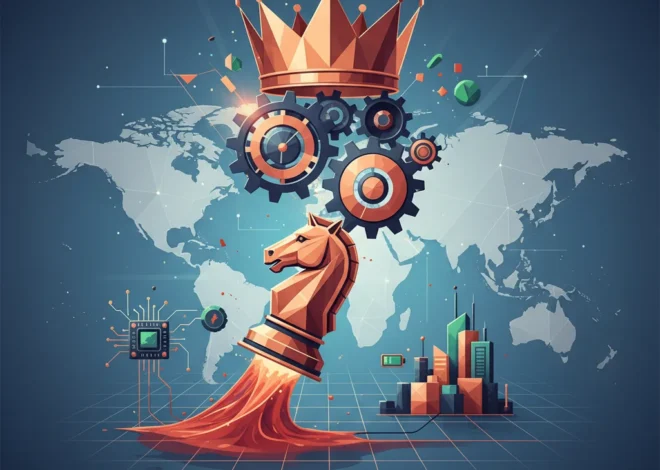
LVMH’s Rebound: Why the Luxury Giant’s Growth is a Bullish Signal for the Global Stock Market
The Glimmer of Gold: Decoding LVMH’s Resurgence
In the intricate world of global finance, certain companies serve as more than just players in their respective sectors; they are economic bellwethers. Their performance offers a glimpse into consumer confidence, discretionary spending, and the overall health of the global economy. Few companies embody this role more perfectly than LVMH Moët Hennessy Louis Vuitton. The luxury conglomerate, a titan of industry with a portfolio spanning from high fashion to fine wines, has recently offered the market a much-needed dose of optimism. After a challenging period for the luxury sector, LVMH’s latest quarterly results suggest a return to growth, signaling that the downturn that has plagued the industry may finally be easing.
For investors, economists, and business leaders, this development is more than just news about expensive handbags and champagne. It’s a critical data point in the complex equation of the modern economy. It speaks to the resilience of the high-end consumer, the shifting dynamics of global wealth, and the potential trajectory of the stock market. As we dissect LVMH’s performance, we’re not just looking at a single company’s financials; we’re analyzing a key indicator that could influence trading strategies, investment portfolios, and our understanding of the broader economic landscape.
A Deep Dive into the Q3 Numbers: The Engine of Recovery
To truly understand the significance of this turnaround, we must look beyond the headlines and into the figures. The narrative of LVMH’s recovery is written in its divisional performance. While the conglomerate as a whole has shown improving trends, the strength is not uniform across its vast empire. This granular view is essential for any serious analysis of the company’s health and its implications for the market.
According to the latest reports, the conglomerate’s overall revenue growth has shown a marked improvement, a welcome sign after quarters of slowing momentum (source). The powerhouse Fashion & Leather Goods division, which includes iconic brands like Louis Vuitton and Dior, continues to be the primary growth driver. This division’s performance is often seen as the truest gauge of aspirational consumer sentiment.
Here’s a simplified breakdown of how LVMH’s key divisions might be contributing to this nascent recovery:
| Business Group | Key Brands | Q3 Performance Analysis | Implication for Investors |
|---|---|---|---|
| Fashion & Leather Goods | Louis Vuitton, Christian Dior, Fendi, Celine | Demonstrated robust, market-leading growth, driven by iconic products and strong brand desirability, especially in Asian markets. | Confirms the enduring power of mega-brands. A core pillar of stability and growth for the LVMH stock. |
| Watches & Jewelry | Tiffany & Co., Bulgari, TAG Heuer | Showed signs of stabilization. High jewelry performed well, though entry-level luxury watches faced some headwinds. | A segment to watch closely. The performance of Tiffany & Co. is a key indicator of the success of its integration. |
| Perfumes & Cosmetics | Dior, Guerlain, Fenty Beauty | Solid performance, buoyed by the recovery in travel retail and innovation in skincare and fragrance. | Represents a more accessible entry point to the LVMH universe, sensitive to broader consumer travel trends. |
| Wines & Spirits | Moët & Chandon, Hennessy, Dom Pérignon | Faced challenges, particularly in the U.S. market, due to post-pandemic normalization and destocking by retailers. | Highlights the cyclical nature of this segment and its sensitivity to specific regional economic conditions. |
This divisional breakdown reveals a nuanced picture. The strength in the core fashion division suggests that the desire for top-tier luxury remains intact. However, the softness in Wines & Spirits points to lingering economic pressures affecting distributor behavior and some consumer segments. For those engaged in stock market trading, understanding this internal dynamic is crucial for accurately valuing the company and forecasting its future earnings potential.
The Macroeconomic Context: Why One Company’s Success Echoes Across the Economy
LVMH’s performance cannot be viewed in a vacuum. It is a direct reflection of, and influence on, the global economy. The “tough couple of years” referenced in market analysis were characterized by a perfect storm of macroeconomic headwinds. Following an unprecedented post-pandemic boom fueled by stimulus and “revenge spending,” the luxury sector faced the harsh realities of soaring inflation, aggressive interest rate hikes by central banks, and geopolitical instability.
These factors directly impact the two core customer bases for luxury goods:
- The Ultra-High-Net-Worth Individuals (UHNWIs): While less sensitive to price increases, their wealth is often tied to the performance of the stock market and other financial assets. Market volatility can create a negative “wealth effect,” leading to more cautious spending.
- The Aspirational Consumers: This group is highly sensitive to inflation, interest rates, and job security. As the cost of living rises and credit becomes more expensive, discretionary purchases like a designer handbag or a luxury watch are often the first to be postponed.
LVMH’s return to a healthier growth trajectory suggests that these pressures may be abating, at least for its target demographic. It indicates that the wealthiest consumers are regaining confidence and that aspirational buyers in key markets may be feeling more economically secure. This is a powerful signal for the broader financial markets. If the top end of the consumer market is stabilizing, it can foreshadow a wider recovery in consumer discretionary spending, a cornerstone of modern economics.
The Geographic Chessboard: Where in the World is Luxury Thriving?
A crucial piece of the puzzle is the geographic distribution of LVMH’s sales. The luxury market is a global game, and regional economic health dictates the winners and losers. The recent recovery has been largely powered by a resurgence in Asian markets, particularly among Chinese consumers, both at home and as they resume international travel. The lifting of travel restrictions has been a massive boon, with tourist hotspots in Europe and Asia seeing a significant influx of high-spending visitors.
A comparative look at regional performance tells a compelling story about the state of the global consumer:
| Region | Performance Trend | Underlying Economic Drivers |
|---|---|---|
| Asia (ex-Japan) | Strong Rebound | Driven by Chinese consumer demand, both domestically and through tourism. The return of travel is a key catalyst. |
| Europe | Resilient Growth | Benefiting from a strong U.S. dollar encouraging American tourism, alongside spending from Middle Eastern and Asian visitors. |
| United States | Normalization / Slowdown | After a period of exceptionally strong growth, the market is normalizing. Higher interest rates and a shift in spending to services are impacting goods. |
| Japan | Exceptional Growth | A weak Yen has made Japan an incredibly attractive shopping destination for tourists, leading to a boom in luxury sales. |
This regional data, supported by industry-wide reporting , underscores the shifting sands of the global economy. The slowdown in the U.S. is a critical trend for investors to monitor, while the strength in Asia confirms its central role in the future of luxury. This geographic diversification is a key strength for a conglomerate like LVMH, allowing it to weather downturns in one region with growth in another.
The Future is Digital: Integrating Financial Technology and Blockchain
While heritage and craftsmanship are the heart of luxury, technology is its nervous system. In an increasingly digital world, LVMH is not just selling products; it’s leveraging technology to enhance authenticity, personalization, and the overall customer experience. This is where the worlds of high fashion and high finance converge, particularly through innovations in fintech and blockchain.
One of the most significant challenges in the luxury market is counterfeiting. To combat this, LVMH co-founded the Aura Blockchain Consortium, a platform that provides a digital certificate of authenticity for luxury goods. By using blockchain, a decentralized and immutable ledger, a brand can create a unique digital twin for each product. This allows a customer to verify the item’s provenance and ownership history with a simple scan, revolutionizing trust and a key concern for those making a significant investment in a luxury item.
Furthermore, financial technology is deeply integrated into the luxury shopping experience. From seamless global online payment gateways to sophisticated customer relationship management (CRM) systems that use AI to predict purchasing behavior, fintech is essential for modern luxury retail. This integration of technology not only improves operational efficiency but also strengthens the direct-to-consumer relationship, providing invaluable data for future business strategy.
Conclusion: A Cautiously Optimistic Outlook for Investors
LVMH’s return to growth is a multifaceted story. On the surface, it’s about the enduring appeal of iconic brands. But digging deeper, it’s a powerful commentary on the state of the global economy, the resilience of the high-end consumer, and the successful navigation of macroeconomic headwinds. For those involved in finance and investing, this is a crucial signal. It suggests that despite inflation and geopolitical uncertainty, wealth and the desire for premium goods remain potent economic forces.
The road ahead is not without its challenges. The normalization in the U.S., the uncertain trajectory of China’s economy, and the ever-present risk of global shocks require a cautious approach. However, LVMH’s performance provides a compelling, data-backed reason for optimism. It reinforces the idea that well-managed, globally diversified companies with strong brand power can not only survive but thrive in a complex economic environment. As the stock market continues to seek direction, the glimmer from the world of luxury may just be the beacon it needs.


